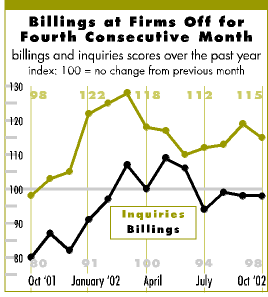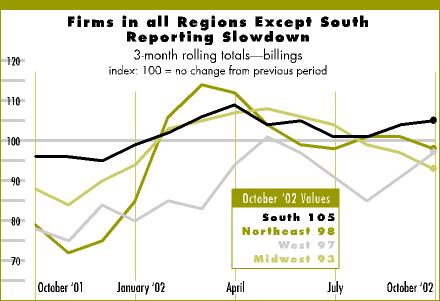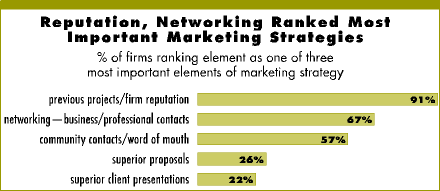
With renewed focus on marketing, firms rely heavily on reputation, networking

Work-on-the-Boards Survey
by Kermit Baker, PhD, Hon. AIA
AIA Chief Economist
Weak business conditions continued at architecture firms nationally. October was the fourth straight month that billings declined at firms, even though monthly declines have remained relatively modest over this period. Inquiries for new projects continued to show modest gains, although apparently many of these inquiries are taking even longer than usual to get translated into new projects.
 Regionally,
the slowdown in work at firms has spread to additional areas. Firms in
the Northeast, Midwest, and West are all reporting modest declines in
billings on average. Firms in the South report continued improvement in
business conditions.
Regionally,
the slowdown in work at firms has spread to additional areas. Firms in
the Northeast, Midwest, and West are all reporting modest declines in
billings on average. Firms in the South report continued improvement in
business conditions.
Economic conditions nationally remain soft. Of particular concern are falling consumer confidence figures. The University of Michigan's Consumer Sentiment index has fallen five consecutive months and now is below levels following September 11 of last year. While a weak job market no doubt is influencing consumer confidence, the impending threat of a war with Iraq is also of critical concern for the consumer outlook.
The October employment report from the Labor Department did nothing to improve the consumer outlook, as business payrolls fell modestly and the national unemployment rate ticked up to 5.7%. The Federal Reserve saw conditions as serious enough to act upon and cut short-term interest rates a half point at its meeting immediately following the national elections.

Marketing increases
in importance
With the recent slowdown in project activity, many firms are finding that
they need to escalate their marketing activities. Members of the AIA Work-on-the-Boards
panel were asked to rank the most important elements of their marketing
strategy.
Though nine potential marketing activities were offered, three responses dominated. "Previous projects/firm reputation" was ranked by 91% of firms as one of their three most important, while 56% ranked this element as the most important of their marketing strategy. "Networking-business/professional contacts" was ranked as among the top three by 67% and as the most important by 16%. "Community contacts/word of mouth" was in the top three for 57% and the most important for 17%.

"Superior proposals" and "superior presentations" were ranked in the top three spots for a marketing strategy by 26% and 22% respectively. "Firm brochures/materials" (15%), "direct marketing" (11%), "firm Web site" (6%), and "firm honors and awards" (2%) were less frequently cited as key marketing elements.
Although smaller firms rely almost exclusively on firm reputation, networking, and community contacts for marketing, larger firms are more diversified in their strategies. Superior proposals and client presentations were generally ranked ahead of community contacts at larger firms, and firm brochures also rank fairly high on the list.
Copyright 2002 The American Institute of Architects. All rights reserved.
![]()
|
This month, Work-on-the-Boards-survey participants are saying: If the late '90s were characterized by "irrational exuberance,"
this period can be seen as "dysfunctional despondency." Payment is getting delayed more each month. More clients are ignoring
their invoices completely. Our firm, which specializes in educational architecture, is still
experiencing a strong market. There is not the quantity of jobs out there, and larger firms are
moving into our type of work to keep their doors open. |
|